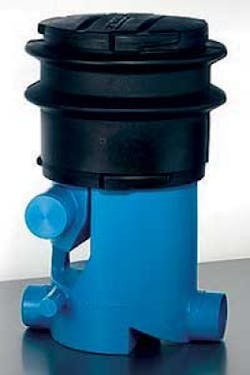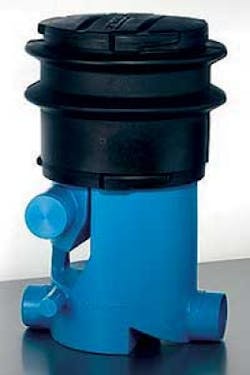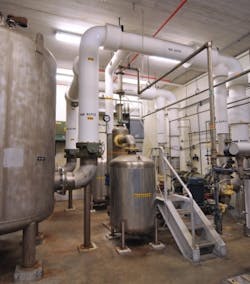System Rehab Reverses Negative Trend with no Cost Increases
By Paul Roux and Jeff Fournier
It may be a cliché, but it’s also true: an ounce of prevention is worth a pound of cure. It certainly was for the Town of Ashland, MA, when it was facing rising total trihalomethanes (TTHM) and haloacetic acids (HAA5) in its drinking water. With the threat of declining water quality and potential compliance violations on the horizon, a timely series of technology upgrades at the town’s 6 mgd Howe Street Regional Water Treatment Facility, which serves the communities of Ashland and Hopkinton, reversed the trend, keeping the levels of both TTHM and HAA5 well within compliance limits and maintaining the high water quality residents expect.
Ashland and Hopkinton are towns of about 16,000 and 14,000 residents, respectively. They are situated midway between Boston and Worcester in eastern Massachusetts. The Howe Street facility, which came on line in 2002, uses upflow clarification, carbon filtration, and ozonation to treat groundwater drawn from five on-site wells. The plant is operated by Woodard & Curran under contract with Ashland and is run by a staff of three. The facility’s comprehensive SCADA system allows for unmanned operations and is accessible from a web-based interface. Following post disinfection and mono-chloramine injection, finished water is pumped directly from the clear well to Ashland and Hopkinton residents by high-service pumps.
Ashland experiences seasonal increases in manganese in its ground water supply, a common problem in New England communities. Although normally found in a divalent form (Mn2+), manganese can also exist in other forms, complicating the selection of removal method. In Ashland’s water, the manganese is organically bound, which means it is sequestered with an organic molecule such as humic, fulvic or tannic acid. Manganese in such a complex is more difficult to treat because the organic molecule provides a protective shell. Treatment of organically bound manganese leaves increased levels of disinfection byproducts in the finished water.
To address the issue, the Howe Street facility was originally designed to use two ozone generators to oxidize the manganese. Unfortunately, the system proved unreliable due to equipment performance issues and operators were never able to keep it running effectively.
“Initially, the ozone units operated well, but we quickly started having mechanical issues with the de-gassing and destruct units,” said Greg Morrissey, Assistant Plant Manager at the facility. “Issues with the check valves at the de-gassing units and the destruct vacuum pumps would allow water to get pulled into the destruct unit, contaminating the media and shutting the system down.”
Plant staff decided that using potassium permanganate to oxidize the manganese and leaving the ozone units off line was a better option. This avoided the problem of repeated shutdowns due to the poorly operating ozone system, and it was somewhat successful for several years. Over time, however, its effectiveness began to diminish and inaction would quickly lead to elevated TTHM and HAA5 that approached the maximum contaminant level violation thresholds.
“We ran with the potassium permanganate for a few years and it really wasn’t effective or efficient,” said Morrissey. “By the end, it was just a waste of money. We knew from the early days of operating the ozone system that it did a good job oxidizing both the manganese and organics, so getting it running was the only effective way to address both contaminants.”
Ozone System Rehab
The task was now clear: bring the ozone units back online. But simply starting up the system wasn’t an option, in part because the issues that had led plant staff to shut them down in the first place remained, and because the system had been off line for long enough that it was in need of significant maintenance and technology upgrades.
As Roy Correia, Foreman for Ashland’s Water and Sewer Division, said, “Fixing the ozone system was just the most sensible thing to do. It was unfortunate that the system had been out of use for a number of years, and we were concerned it would require a whole new system, but it turned out that wasn’t necessary.”
The first step was to determine exactly what had to be done to return the ozone units to operation. To accomplish this, an engineer was brought in to analyze the system and recommend improvements and necessary maintenance. The report listed a number of changes, including relocating several valves for easier adjustment and maintenance, installing blow-down valves and drain lines for the de-gas system, and modifying the de-gassing and destruct units to vent to the entrained water separator without the need for vacuum pumps.
Another important piece of maintenance and modification was a complete cleaning and rebuilding of the dielectric modules in both ozone units. The modules had become fouled through use and had now sat idle for long enough that simply using them as-is was not a good option. While completing that service, the units were adapted to simplify future maintenance significantly, making the system less expensive to maintain.
Once the modifications were in place, the next step was starting up the units to determine if they were working properly. This would highlight any additional issues and allow plant staff and contractors to fix them before bringing the system on line. After determining that the units were working well, some additional changes were made to the PLCs and monitors. All the ozone monitors were calibrated and certified, and the PLC program was modified to coordinate operation of the ozone units with plant operations, avoiding running the system when it was not needed.
Plant staff also determined that the ozone concentration analyzers were unreliable, causing far more liquid oxygen to be injected in to the contact tank than was necessary. This was a significant waste of the expensive chemical. Fortunately, the solution was simple: leave the analyzers off line and set the concentration manually. This may seem counter-intuitive, but in the end it was far more reliable than using the concentration analyzers, and far more cost-effective as well.
“Once the maintenance and upgrades were complete,” said Correia, “we turned on the system for the following season and the results were dramatic. It’s been running great. At the start of the project we said that our goal was to have the high water quality we wanted, and so far, so good.”
WW
About the Authors: Jeffery Fournier is the Plant Manager for the Howe Street Regional Water Treatment Facility. He is responsible for managing the budget and overseeing plant operations and maintenance. He has a background in process control optimization, troubleshooting chemical feed systems, and a range of SCADA software and hardware systems. Paul Roux is a Vice President with Woodard & Curran and has over 16 years of experience managing and operating water treatment facilities. He has particular expertise with SCADA and treatment systems, as well as ozone, UV, and chlorine dioxide systems for precursor and organics removal. For more information on the firm visit www.woodardcurran.com.
More WaterWorld Current Issue Articles
More WaterWorld Archives Issue Articles



